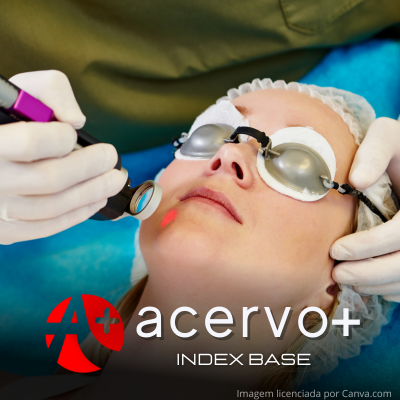Laserterapia de baixa intensidade como abordagem terapêutica para disfunções temporomandibulares: revisão de literatura
##plugins.themes.bootstrap3.article.main##
Resumo
Objetivo: Revisar a literatura acerca do uso do laser de baixa intensidade como escolha de tratamento para disfunções temporomandibulares (DTM). Métodos: Pesquisaram-se os descritores “temporomandibular joint disorders”, “phototherapy” e “low-level light therapy”, conectados pelo operador booleano “AND”, na base de dados Pubmed nos últimos 5 anos. Resultados: Obtiveram-se 75 artigos, sendo selecionados 11 estudos, com base na leitura de títulos e resumos. Foram incluídos artigos em inglês e disponíveis na íntegra que relatassem o tema referido. Foram excluídos estudos laboratoriais, revisões de literatura e artigos que não abordassem o assunto. Foi selecionado um ensaio clínico que observou que o uso da fotobiomodulação com LEDs (Light-Emiting Diode), que são diodos emissores de luz, que ajudam a melhorar a limitação na movimentação da mandíbula. Foi eficaz nas atividades musculares. Apenas um estudo clínico inferiu que a laserterapia foi eficaz isoladamente e 9 estudos clínicos concluíram que o laser de baixa intensidade (LBI) quando associado a outras terapias promove efeitos positivos. Considerações finais: Em suma, os artigos demonstraram a eficácia da LBI para o tratamento da DTM, principalmente quando gerenciados em uma abordagem terapêutica multidisciplinar.
##plugins.themes.bootstrap3.article.details##
Copyright © | Todos os direitos reservados.
A revista detém os direitos autorais exclusivos de publicação deste artigo nos termos da lei 9610/98.
Reprodução parcial
É livre o uso de partes do texto, figuras e questionário do artigo, sendo obrigatória a citação dos autores e revista.
Reprodução total
É expressamente proibida, devendo ser autorizada pela revista.
Referências
2. AISAITI A, et al. Effect of photobiomodulation therapy on painful temporomandibular disorders. Sci Rep, 2021; 11(1): 9049.
3. AL-QUISI AF, et al. The reliability of using light therapy compared with LASER in pain reduction of temporomandibular disorders: a randomized controlled trial. BMC Oral Health, 2023; 23(1): 91.
4. AYYILDIZ S, et al. Evaluation of Low-Level Laser Therapy in TMD Patients. Case Rep Dent, 2015; 2015: 1-6.
5. BROCHADO FT, et al. Comparative effectiveness of photobiomodulation and manual therapy alone or combined in TMD patients: a randomized clinical trial. Braz Oral Res, 2018; 32: 1-12.
6. CHELLAPPA D e THIRUPATHY M. Comparative efficacy of low-Level laser and TENS in the symptomatic relief of temporomandibular joint disorders: A randomized clinical trial. Indian J Dent Res, 2020; 31(1): 42-47.
7. COSTA SAP, et al. The analgesic effect of photobiomodulation therapy (830 nm) on the masticatory muscles: a randomized, double-blind study. Braz Oral Res, 2017; 31: 1-7.
8. DANTAS CMG, et al. The influence of educational measures and low-level laser phototherapy on temporomandibular disorders: Study protocol clinical trial (SPIRIT Compliant). Medicine (Baltimore), 2020; 99(10): 1-8.
9. DEMIRKOL N, et al. Efficacy of Low-Level Laser Therapy in Subjective Tinnitus Patients with Temporomandibular Disorders. Photomed Laser Surg, 2017; 35(8): 427-431.
10. DONNARUMMA MDC, et al. Temporomandibular Disorders: signs, symptoms and multidisciplinary approach. Rev. CEFAC, 2010; 12(5): 788-794.
11. FERREIRA LA, et al. Laser acupuncture in patients with temporomandibular dysfunction: a randomized controlled trial. Lasers Med Sci, 2013; 28(6): 1549-58.
12. HAMBLIN MR, et al. Photobiomodulation and Cancer: What Is the Truth? Photomed Laser Surg, 2018; 36(5): 241-245.
13. LANGELLA LG, et al. Photobiomodulation versus light-emitting diode (LED) therapy in the treatment of temporomandibular disorder: study protocol for a randomized, controlled clinical trial. Trials, 2018; 19(1): 71.
14. LIMA MCR et al. Controle da disfunção temporomandibular utilizando a laserterapia. Revista Eletrônica Acervo Saúde, 2021; 13(4): e7281.
15. MACHADO BC, et al. Effects of oral motor exercises and laser therapy on chronic temporomandibular disorders: a randomized study with follow-up. Lasers Med Sci, 2016; 31(5): 945-54.
16. MELCHIOR MO, et al. Effect of speech-language therapy after low-level laser therapy in patients with TMD: a descriptive study. Codas, 2016; 28(6): 818-822.
17. OHRBACH R, et al. Clinical orofacial characteristics associated with risk of first-onset TMD: the OPPERA prospective cohort study. J Pain, 2013; 14: 33- 50.
18. PESSOA DR, et al. Association of facial massage, dry needling, and laser therapy in Temporomandibular Disorder: case report. Codas, 2018; 30(6): 1-6.
19. RODRIGUES MDF, et al. Effects of low-power laser auriculotherapy on the physical and emotional aspects in patients with temporomandibular disorders: A blind, randomized, controlled clinical trial. Complement Ther Med, 2019; 42: 340-346.
20. SERIQUE AVC, et al. Laser therapy in the treatment of temporomandibular dysfunction, trismus and xerostomia of oncologic patient: case report. Revista Eletrônica Acervo Saúde, 2021; 13(1): e5129.
21. SOUSA DFM, et al. Photobiomodulation with simultaneous use of red and infrared light emitting diodes in the treatment of temporomandibular disorder: study protocol for a randomized, controlled and double-blind clinical trial. Medicine (Baltimore), 2019; 98(6): 1-7.
22. SHOBHA R, et al. Low-level laser therapy: A novel therapeutic approach to temporomandibular disorder - A randomized, double-blinded, placebo-controlled trial. Indian J Dent Res, 2017; 28(4): 380-387.
23. WIECKIEWICZ M, et al. Reported concepts for the treatment modalities and pain management of temporomandibular disorders. J Headache Pain, 2015; 16(1): 1-12.

